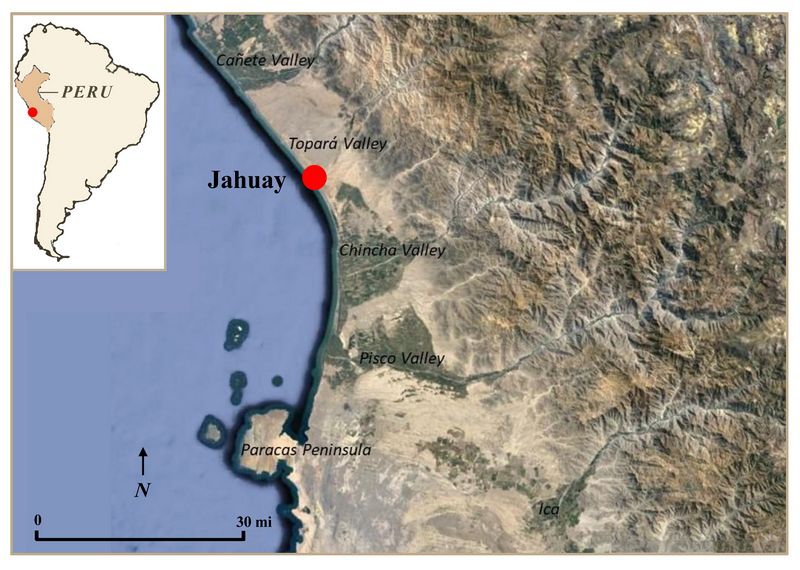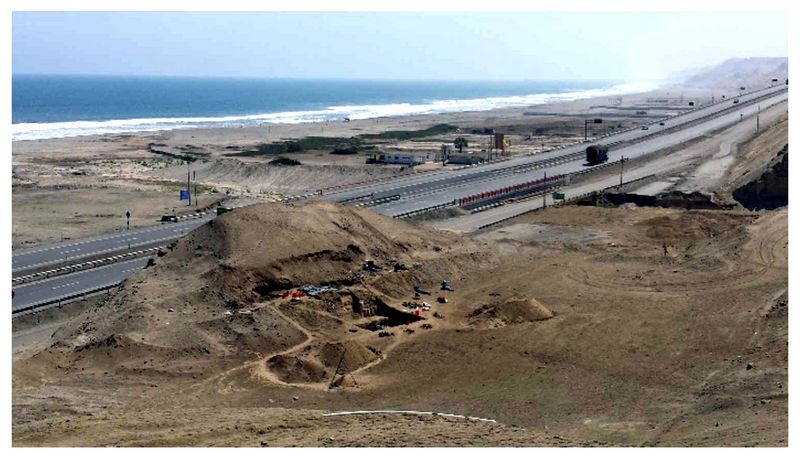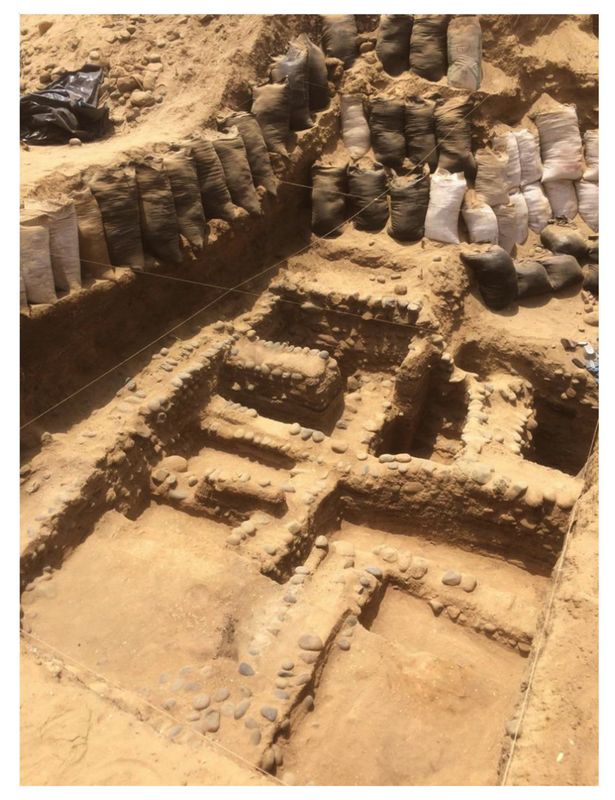Rust Family Foundation: Archaeology Grants Program
Negotiated Subsistence:
Desert Resources and Early Agriculture in the Late Paracas Period, Peru
[RFF-2018-82]Principal Investigator: Camille Weinberg
Department of Anthropology, University of Texas at Austin.
The Paracas Period (approximately 800 BCE–200 CE) on Peru’s South Coast saw the rise of the region’s first complex society and increasing commitments to agriculture in the region’s fertile coastal river valleys. However, a longstanding archaeological focus on Paracas elites and mortuary and monumental sites in the largest river valleys means we still lack comprehensive evidence of commoner adaptations in this hyperarid, drought-prone coastline that was environmentally risky, yet rich in wild natural resources.

Fig.1: Location of Jahuay and the neighboring river valleys on the south coast of Peru (aerial image: Google Earth).
This project investigates subsistence strategies, and specifically plant use, of commoners in the late Paracas Period (approximately 300 BCE–100 CE) to understand early agricultural production and wild resource exploitation. RFF funding supported a second season of fieldwork in the Topará Valley at a non-elite, Late Paracas littoral site called Jahuay (fig.1) in 2018 by the Proyecto de Investigación Arqueológica Jahuay (PIAJ), co-directed by Camille Weinberg, Jo Osborn (University of Michigan), and Kelita Pérez Cubas (Pontificia Universidad Católica del Perú). The architecture documented in these excavations, as well as the abundant material remains collected by PIAJ, provide new data on the Late Paracas period, and were salvaged from additional destruction at a heavily disturbed and vulnerable archaeological site (fig.2).
Previous Work at the Site:
Until PIAJ’s research at Jahuay, both the site and the Topará Valley were the subject of only limited scientific investigation. Jahuay was documented in one regional survey (Engel 2010), and Edward Lanning (1960) excavated test pits at the site. Lanning described looted Late Horizon tombs, terraced hillsides, and shell middens situated around a natural mound at the center of Jahuay, where he interpreted one context as a semisubterranean domestic structure. He suggested that Jahuay was a fishing village, something the PIAJ excavations have supported with more subsurface data. His analysis focused on the monochrome ceramic collection by which he defined the Topará ceramic style that has come to serve as the marker for the Late Paracas tradition across the South Coast. Therefore, Jahuay has long been known as the type-site for this defining regional Late Paracas ceramic style and additional work in the Topará Valley and neighboring Cañete Valley has been considered key to better understanding the Topará/Late Paracas culture and the regional sociopolitical shifts that occurred in the final centuries BCE across the South Coast.

Fig.2: View of Jahuay from the southeast, showing the 2018 excavation area in Sector B.
PIAJ conducted initial excavations at Jahuay in 2017, excavating three sectors to assess the site’s layout and degree of site preservation. The fieldwork highlighted extensive destruction to the site by looting, construction, and flooding, but revealed intact Late Paracas floors and low terraces on a natural mound and on the steep surrounding hillsides. Excavations also discovered a previously unreported later period occupation at Jahuay that was associated with the looted Late Intermediate Period/Late Horizon cemetery on the hillside. Our 2018 follow-up season targeted the Late Paracas contexts with the hope of finding extensive intact remains, and especially domestic contexts by which to reconstruct early life there.
Current Project (RFF-2018-82)
Goals:
The goal of the 2018 excavation project was to focus on the best-preserved areas of Jahuay identified in the 2017 field season where Late Paracas contexts appeared to be intact. PIAJ aimed to open broad horizontal exposures at Jahuay to uncover undisturbed subsurface of Late Paracas domestic contexts, middens, and architecture from which to collect evidence of diet in the littoral zone. We also sought to produce the first radiocarbon dates for both Jahuay and the Topará Valley.
Methodology:
PIAJ’s 2018 excavations at Jahuay focused on Sector B, within a continuous block of 2m2 units spanning the eastern slope of the natural mound at the center of the site where Lanning dug decades ago. Additional extending units were added to follow features. Excavations followed natural stratigraphic levels and employed some arbitrary levels as necessary to control resolution. In the field, ceramics, macrobotanical remains, shells, textile fragments, animal and human bones, artifacts, lithics, and charcoal were collected from excavation screens. We also collected sediment samples for microbotanical analyses of hearth and midden contexts.
Follow-up analyses included manually floating dozens of sediment samples from the excavations, and analyzing the macrobotanical remains, human remains, and marine mollusk assemblage. Analyses of the faunal remains, charcoal and ceramics are forthcoming. Microbotanical analyses of phytoliths are underway at the Environmental Archaeology Laboratory at the University of Texas at Austin to reconstruct plant use at Jahuay. PIAJ also submitted 9 charcoal samples from Jahuay to the National Ocean Sciences Accelerator Mass Spectrometry facility for radiocarbon dating.
Results from current project:
Excavations:
The 2018 excavations did not reveal domestic contexts but successfully exposed undisturbed phases of architectural construction corresponding to the Late Paracas occupation. The fieldwork also revealed additional destruction to the site—a
 fiberoptic cable illegally installed through
the natural mound feature. Although it was largely destroyed by this
intrusion, we excavated the remains of a Late Paracas enclosure here,
constructed from walls of river cobbles. While the original purpose of
the room is unknown, it was later filled with deep, stratified midden
deposits dominated by marine bivalves including the clam Donax obesulus and the mussel Semimytilus algosus.
fiberoptic cable illegally installed through
the natural mound feature. Although it was largely destroyed by this
intrusion, we excavated the remains of a Late Paracas enclosure here,
constructed from walls of river cobbles. While the original purpose of
the room is unknown, it was later filled with deep, stratified midden
deposits dominated by marine bivalves including the clam Donax obesulus and the mussel Semimytilus algosus. PIAJ also excavated part of a preserved Late Paracas building just east of the mound, over 2 meters below the bulldozed ground surface (fig.3). Low interior cobblestone dividing walls delineated small areas possibly for storage or workspaces. Artifacts recovered here suggest activities like weaving cotton nets to facilitate processing and capturing marine resources.
Fig.3: A view from the east of the Late Paracas building.
Together, the material culture from the building and midden indicate that subsistence at Jahuay focused on exploiting diverse local marine fauna: fish, mollusks, sea lions, dolphins, and sea urchins. Net-making tools, needles, raw cotton and abundant gourd fragments suggest Jahuay’s residents may have been producing much of what they needed for fishing, including nets and gourd floats (fig.4).

Unexpectedly, in upper strata of the excavations PIAJ encountered several undisturbed and several disturbed burials ranging in age from infant to adult. While radiocarbon dates are forthcoming, we hypothesize based on stylistic attributes that two of these date to the Late Paracas period, while the others are probably from more recent periods (e.g. the Late Intermediate or Late Horizon) when parts of Jahuay were reoccupied and a cemetery was established on the surrounding hillside. These excavated human remains offer new evidence for future study by bioarchaeologists.
Fig.4: Artifacts associated with the Late Paracas building; net making tools, needles and fish hook.
Botanical Analyses:
The macrobotanical analysis shows that Jahuay’s residents used a relatively limited suite of domesticated plant species common to contemporaneous sites including cotton, gourds, squash, beans, peanuts and some corn. There were notably few cultivated fruits as known from other sites, such as lucuma, avocado or chile peppers. Gourd and squash could possibly have been cultivated locally at low levels, but we found no direct evidence of plant cultivation at Jahuay itself and macrobotanical remains were primarily edible plant parts. Together with cotton, these species may have been essential to the marine subsistence base. Weaving tools, raw cotton, and net fragments indicate that residents made cotton fishing nets, and gourds may have been used for fishing floats. Jahuay may have received these and comestible cultigens through economic relationships with other sites, including, perhaps, the Chincha Valley.
Residents also used diverse wild plant resources. We identified reed grasses (Phragmites australis, Gynerium sagittatum), sedges, cattails, and bromeliads (Tillandsia sp.) from fog-fed desert lomas vegetation and coastal wetlands that must have been more extensive during the occupation. High quantities of Tillandsia suggest lomas played an important role in providing fuel resources. Wood fragments, most of which could not yet be identified taxonomically, suggest riparian dry forest ecosystems may have once been available. Beresford-Jones, Lewis and Boreham (2009) demonstrated the existence of extensive riparian dry-forest ecosystems in the nearby Ica Valley in prehispanic periods.
Early results from the ongoing phytolith analyses are consistent with the macrobotanical assemblage—the most abundant phytolith forms are from grasses, but there are also forms from dicotyledonous trees and shrubs. Samples from the hearths within the Late Paracas building have some comestibles, such as squash. Ultimately, we can say that more diverse and extensive vegetation was available to populations in this desert in the past and there was substantial use of wild resources despite the availability of domesticated plant species. Continued microbotanical analyses and expert analysis of the charcoal remains and flotation samples should generate a more comprehensive picture of resource exploitation.
Radiocarbon Dating:
The radiocarbon samples excavated from multiple sectors of Jahuay in 2017 yielded dates ranging from 410 to 41 cal BCE. These demonstrate that the Jahuay occupation was contemporaneous with Late Paracas sites in the lower Chincha Valley, including El Mono, Cerro del Gentíl, La Cumbe, and Huaca Soto (Stanish et al. 2014, Tantaleán et al. 2016, Nigra 2017). The dates also suggest a relatively long period of exploitation here on the littoral, raising questions about economic and political relationships between these sites given that no other contemporaneous sites are known from the Topará Valley.
Conclusion:
Overall, this RFF-funded excavation project recovered new architectural, mortuary, and dietary data that now provide the most comprehensive evidence for commoner lifeways at Jahuay, and in the Topará Valley, in the Late Paracas period. These investigations at the mouth of the valley help to fill in the regional map for this time period, especially as no radiocarbon dates previously existed for this valley or any Late Paracas occupations in the neighboring Cañete Valley to the north. This research generated the first radiocarbon dates for Jahuay, which demonstrate a coastal occupation focused on the exploitation of marine resources existed here from 410-41 cal. BCE. The excavated contexts raise interesting questions about the strategies occupants used to exploit wild plant and animal resources in the desert and the economic and political relationships that supported their marine-based subsistence here along the littoral for nearly four centuries.
References:
Beresford-Jones, David, Helen Lewis, and Steve Boreham. 2009. “Linking Cultural and Environmental Change in Peruvian Prehistory: Geomorphological Survey of the Samaca Basin, Lower Ica Valley, Peru.” Catena 78 (3): 234–49. https://doi.org/10.1016/j.catena.2008.12.010.
Engel, Frederic. 2010. Arqueología Inédita de la Costa Peruana. Asamblea Nacional de Rectores. Lima.
Lanning, Edward P. 1960. "Chronological and Cultural Relationships of Early Pottery Styles in Ancient Perú." Doctoral dissertation. Department of Anthropology, University of California, Berkeley.
Nigra, Benjamin T. 2017. “Huaca Soto and the Evolution of Paracas Communities in the Chincha Valley, Peru.” Doctoral Dissertation. University of California, Los Angeles.
Stanish, C., H. Tantalean, B. T. Nigra, and L. Griffin. 2014. “A 2,300-Year-Old Architectural and Astronomical Complex in the Chincha Valley, Peru.” Proceedings of the National Academy of Sciences 111 (20): 7218–23. https://doi.org/10.1073/pnas.1406501111.
Tantaleán, Henry, Charles Stanish, Alexis Rodríguez, and Kelita Pérez. 2016. “The Final Days of Paracas in Cerro Del Gentil, Chincha Valley, Peru.” PLoS ONE 11 (5): 1–21. doi:10.1371/journal.pone.0153465.
Recent Foundation grants: general Archaeology Grants Program w/map
Copyright © 2019 Rust Family Foundation